How To Attain True Connection With Your Dressage Horse
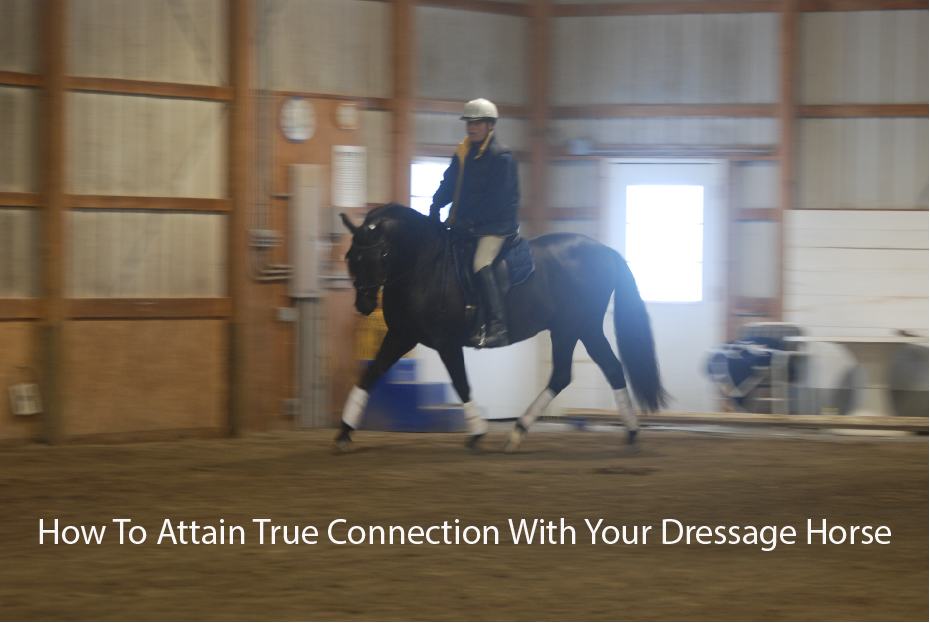
“Dressage training methods of Iberian horses is best approached slightly differently versus their warmblood cousins,” explains long time horse breeder and international dressage competitor/coach/clinician Paul Alvin-Smith.
Based on his training experiences making several horses from start to Grand Prix success, British/American Paul generously shares his wealth of knowledge on how training protocols are adjusted in his program at Willowview Hill Farm, in the Catskill Mountains of New York, for both equine homebreds and horses that are brought to his private yard for training help.
CH: Can you share some insight into the different breeds you have trained through the levels, and what you mean when you say a slightly different approach is needed for Iberian horses versus warmblood horses?
Paul: My wife and I began our horse breeding program back in the late 1980’s. Warmbloods were scarce on the ground in the U.S.A., so we imported some horses and also bought some mares and foals that were on the floor here as foundation stock. After 20 or so years of Hanoverian, Oldenburg and Dutch breeding we migrated to breeding Andalusians and Lusitanos. We were breeding Iberian horses and visiting Spain and Portugal for stock, long before they became popular in dressage here. Like so many other dressage riders, we appreciated the Iberian horse for its versatility, overall soundness and ability to collect. The challenges of training an Iberian horse are its generally shorter back, more compact frame and deep neck and chest.
The mental and physical attributes in the Lusitano and Andalusian pedigrees mean that early training of these horses in particular, needs to be addressed differently. A warmblood is bred for a very forward and elevated movement. They are powerful horses that tend to thrust themselves into the bridle as youngsters, and trainers sometimes mistake that forward momentum as the horse being engaged. Which of course its not. An Iberian horse on the other hand, does not necessarily have the same urge to forwardness. Neither horse should be rushed of its feet in tension to send it up to the bit. But the warmblood horse will generally take more seat and demand strength in core of the rider to bring its back up, while the same amount of aid on an Iberian horse will encourage it to sink below the rider and elevate its head and neck. Again, incorrect connection.
CH: Can you share an example of what you mean and the problems that such riding challenges can present?
Paul: Sure. A common problem I see into my yard with Iberian horses that arrive from boot camp or training programs elsewhere is the break of the neck at the 3rd vertebrae and a lack of trust in the bit and rider’s hand. Inheriting a horse that has been trained incorrectly and breaks at the 3rd vertebrae is very difficult to resolve. But it is possible with patience and consistency.
It is much easier to work a horse correctly from the beginning than to have to 'fix' an issue later on as we all know. A great example is a lovely ANCCE stallion we trained a while back. Our protégée had received minimal training and but had shown at Training Level in Canada ~ however somewhere along the line he was ridden incorrectly and allowed to hide behind the vertical. Though he scored well the judge’s comments noted inconsistent contact.
As he did not have an excessively long neck this was an interesting achievement. How to resolve it?
We began by working him a little in front or above the bit, sending him forward and setting a good rhythm from the get-go. Then I encouraged him to take the reins and stretch over his back and out down in front, without putting his head too low i.e. not below the knee - he had to learn to take the contact and to take his part of it consistently. This requires a very good seat from the rider and is best done first at the working trot posting. I also worked him in shoulder fore, shoulder in and counter flexed to the outside to supple his neck and his sacroiliac.
As a stallion his neck was large with a big crest and a lot of lower neck development that I needed to 'remove' and put on to the top line where it belongs. But that neck muscle must emanate from the wither forward as he progresses, not from the top of the neck backward, or you will see the 'ugly' sausage muscle that says loud and clear, this horse has been ridden with too much hand and from front to back instead of the other way around.
Interestingly this horse did not exhibit the "broken at the 3rd vertebrae neck" in the canter. This is because his canter was easily his best gait. He liked to be round and forward. I also believe it is because this gait had not been overly schooled, historically. I used his canter to 'show him the way forward' with frequent correct transitions. This means I had to make him strong enough and balanced enough (hence the lateral work), to make an upward transition without needing to throw his head above the bit and make a downward transition without falling on his front end. This was achieved by correct timing of the aids, an open and not a driving seat but a 'still' seat during transitions and a quick move to posting on the downward transition and re-balancing through the half halt before, during and after the transitions.
The horse also lacked gaskin development indicating that he was not carrying himself properly behind, and he was pushing forward rather than lifting forward. At his stage of development he was built higher behind than in the front, a common issue with Andalusians. In fact the ANCCE breed inspectors (the much revered and appreciated Spanish Andalusian registry) actually prefer a higher croup than wither. As a dressage rider we know we are fighting a 'downhill' battle with this type of conformation. But again, correct work will help. As the horse learned to take his own weight backward and to lift correctly, through frequent transitions, lateral work and counter flexion in all gaits, his sacroiliac region strengthened and his ability to carry improved.
It is essential that the horse wasn’t overworked during this period. The work must be kind and not overly enthusiastic or the horse will become tired. This is hard work for them. Thankfully this horse had good hocks and no 'wobbling' in his fetlock or hock joints. That would require a different approach. I employed frequent walk breaks in an active but uncluttered or unfettered walk i.e. not interfering all the time as a rider but just allowing the horse to move forward, was beneficial. It is important that even when walking on a long rein the horse be required to be 'out there' in front, taking the rein contact softly as he covers the ground, relaxed across his top line.
CH: How did you know when you had the stallion back on the right track in his work and that you can move past this stage?
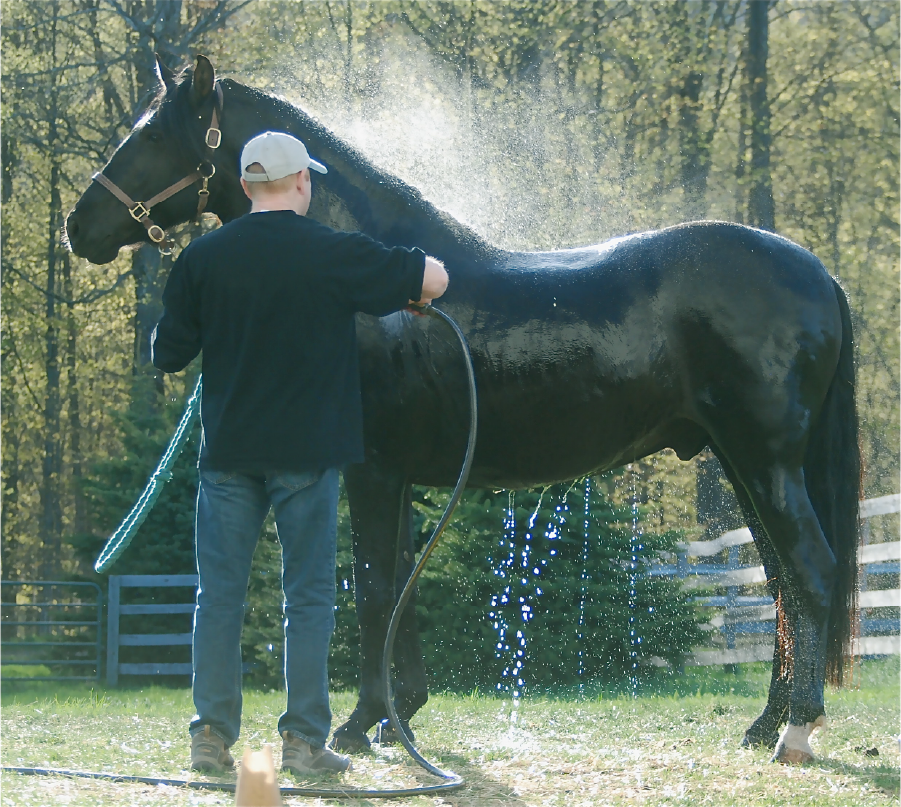
Paul: The wither will essentially 'pop'. You will go to re-stick re-measure with a measuring hand stick) your horse and find he has grown an inch or two. His gaskin will be evenly developed and bulging nicely when the horse is viewed from behind. Look for the horse to show even amounts of bulge on each hind leg. Any difference is an indicator of incorrect work or unsoundness. And the neck will be soft, the muscles rolling and rippling as he works. The sacroiliac will be soft and supple and the horse will easily bend around each of your legs as requested instead of 'blowing off' your leg, avoiding bend, stiffening against the bend, shoving shoulder out of alignment etc. In many years of buying both young and proven international Grand Prix horses, that look from behind tells you everything. Don't get me started on that topic.
CH: Are there other issues you should consider as the reason for a break at the 3rd vertebrae?
Paul: When working your horse through this transition to correct work be aware that if you are 100% certain you are riding the horse correctly and he still cannot access the correct contact you may need to have a chiropractic exam. So often young horses are tied up then they panic or struggle for one reason or another and pull vertebrae in the neck. This is a reason we never tie foals. My pet hate is the cross tied horse for the farrier.. again, don't get me started. It is also a reason we don't use cross ties, but if you must, be sure they are Velcro breakaways. The emergency snaps are not good. I have seen them hit a horse in the face and pull off at the wall and be dragged behind and around the horse during his panic, I have also known one friend to lose fingers trying to unsnap them.
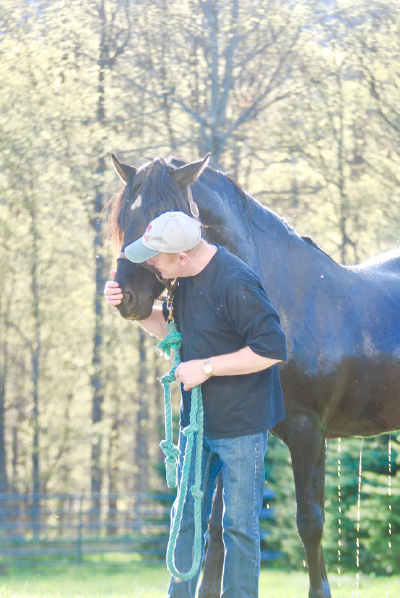 I see a lot of imported Iberian horses arrive in the country with this issue. It has become much better as training in Portugal and Spain has become better just as it has here in the U.S.A. But when horses are prepped for market on the Continent, whether that is warmbloods in Germany or Iberians on the Andalusian Peninsular, the need to get the horse to market and show off its potential often results in rushed basic training too.
I see a lot of imported Iberian horses arrive in the country with this issue. It has become much better as training in Portugal and Spain has become better just as it has here in the U.S.A. But when horses are prepped for market on the Continent, whether that is warmbloods in Germany or Iberians on the Andalusian Peninsular, the need to get the horse to market and show off its potential often results in rushed basic training too.
CH: Continuing the conversation on how the trainer should expect the horse with this 3rd vertebrae disconnect to improve. What are the next steps in the training process? When do you know you are there?
Paul: Once you have been working your horse softly and gaining ground and lift in his strides, being certain that he steps brightly forward to the bridle and takes his part of the equation you can begin to move forward. Focus had been on switching between the posting trot, where we began and established a relaxed, forward but not rushed, rhythm, to the sitting trot for just a few strides and then back to the post. The purpose was to be certain he was first off working correctly through his topline and building back strength before we sit and ask him to properly carry the rider's weight for longer periods. As a young horse the back is not developed and their sacroiliac can become stiff and tense if we over ask.
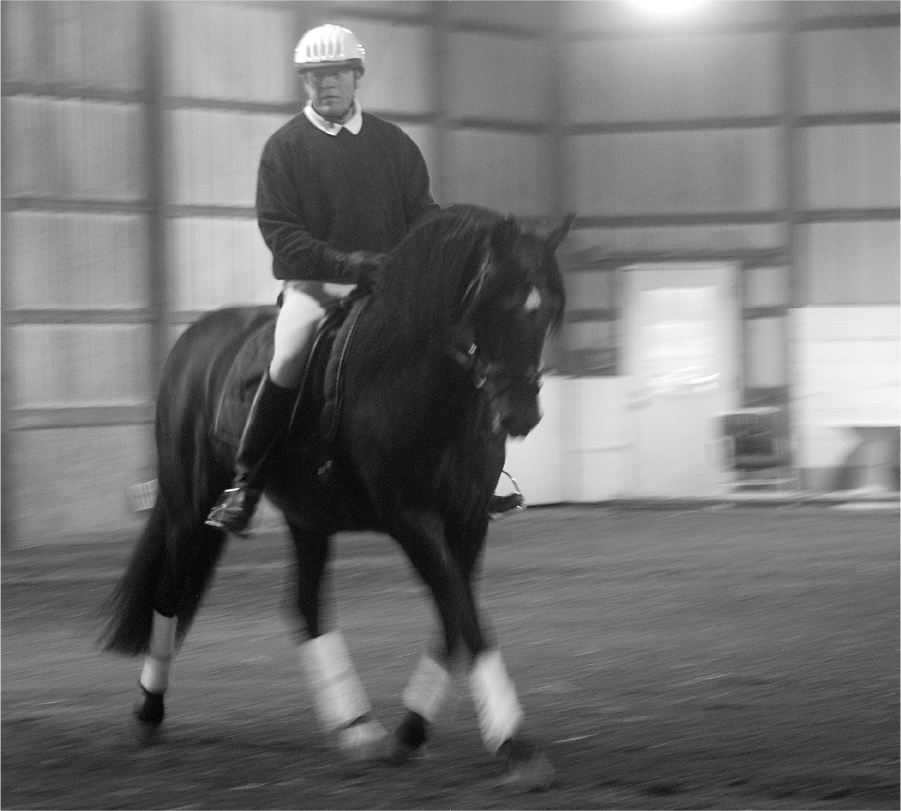
Sometimes when the rider sits, this horse comes up into the bridle and slightly in front of the vertical. While this looks very pretty and an uneducated eye might perceive this as correct, we can see that the horse is not 'waving' through his back but rather carrying with tension. The rider gently shows him the way back down and forward, the horse's nose will come slightly behind the vertical but he bascule over his back. The horse must not be 'down' low or 'curled behind' and neither must he drop the contact. As time progresses the horse will be able to carry the rider for longer periods and through upward and downward transitions working from back to front.
Lots of work with outside flexion had been needed, as like most horses this horse likes to blow off the left leg. As soon as he waivers from accepting the action of the outside leg and either drifts off left on the circle, pops his shoulder, or deviates from the correct bit connection when working on the right rein, I take the horse's head to the outside of the circle (the new inside), and apply the outside leg on the girth ( now becoming the inside leg). There is a necessary give in what was the inside rein (right rein) and is now the outside rein, and a vibration of the new outside rein. The rider's inside leg taps politely asking the horse to yield in his topline and rib cage and bend around the new 'left post leg.' Once this is 'accepted' by the horse he is allowed to return with his head and aids flexed inside, and ridden once more from inside leg to outside hand.
Canter work at this stage was short and of quality. The horse bent around the inside leg in a slight haunches-in to allow him to find the correct lead, the inside rein is promptly released as the leg aids are given, and the return to the trot occurs within 6 or 7 strides. If the horse plows down in the downward transition, the rider should quickly release the inner rein, issue small half halts unilaterally on the outside rein and proceed to set the slow but forward posting trot rhythm. It is important to maintain calm at all times and use the created forward energy to encourage the horse to step smartly underneath himself with legs being used softly but assertively. The horse must not learn to blow off the leg during downward transitions. Timing here is everything. More on that another time. A good trainer will quickly see if you are jabbing the horse with the rein, asking for the half halt too long or too strongly or blocking the inside shoulder. You can also think of shoulder in position when you make the downward transition. If your horse really won't listen, then take his head in counter flexion to the outside, send his haunches to the inside and ask for the downward transition again.
CH: What other training exercises should the trainer employ to help progress the correct connection of the horse through the bridle?
Paul: Suppling exercises are very important to correct the connection issue. The horse must have some shoulder fore, shoulder in, but not too much bend. The important use here is forward, not four tracks or an FEI level shoulder in. Three strides off a circle or out of a corner, or down the 1/4 line in shoulder in, followed by 3 steps straight, and repeat. If the horse backs off at all, ride some lines straight before returning to asking for shoulder in. The shoulder in is an opportunity to check your work, as you bring the head up and ride into the connection from your hip to outside 'wall' rein', which slightly blocks and the inside rein that is soft. Neither rein is stiff, both reins are vibrating slightly. Legs are not supportive but tapping. It may help you to take your stirrups away to get that feel. Many riders think they are tapping but are in fact, gripping. Or their legs are too tight in the thigh gripping and though their ankles bounce a little, their lower legs are stiff and not reaching the horse's side.
Here are some comparison photos to show you: The first photo is the young Andalusian stallion working in suppling trot.
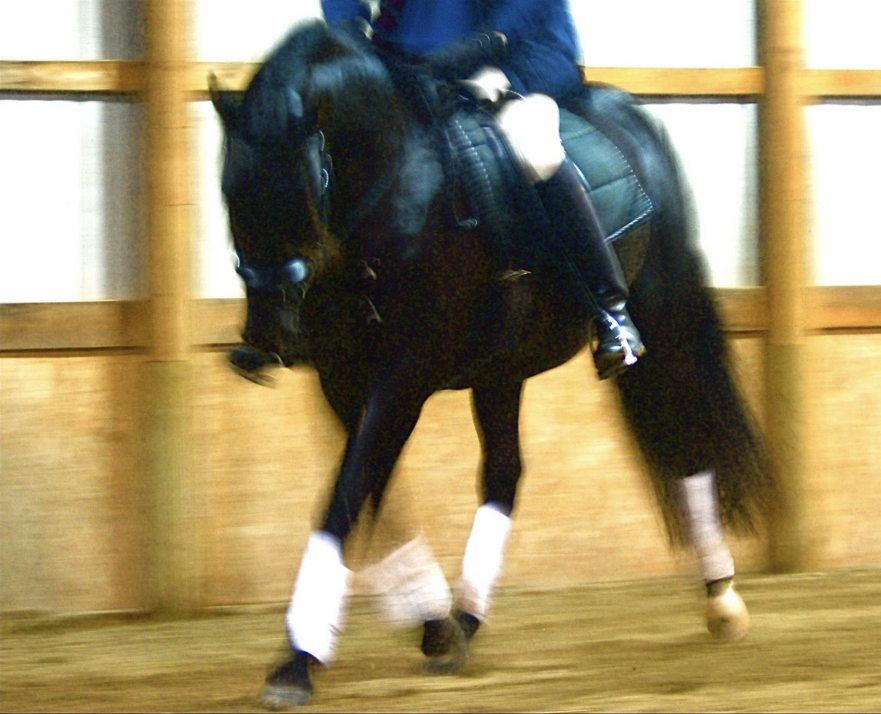
The second photo is of our Dutch warmblood cross, Grand Prix horse Charrington, taken some years ago, when he was working into proper connection.
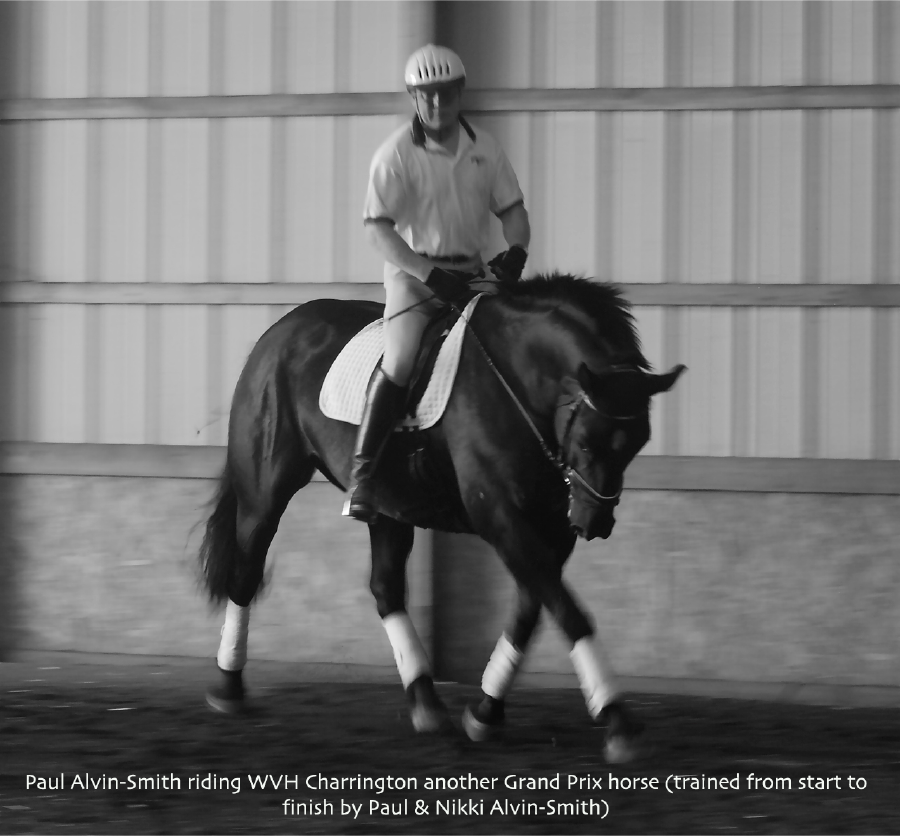
He, like the youngster, had a very thick neck as he was gelded late. He also has a very angled but big shoulder which needed to be 'freed.' These horses have much in common. Both have wonderful work ethics, both are black as night, but Charrington had the advantage of never being allowed to 'hide'. This suppling work takes accuracy and patience. Notice both horses have 'listening' ears.
We then progressed to bringing the horse 'up' more of the time, as his back tells us it is strong enough and his gaskin muscle shows more development. Ideally I will see more elevation in the placement of the front hooves as his hind feet step up from behind and more bend in the forward knee. This freedom of shoulder movement is a good indicator of the back strength developing correctly.
I am pleased to report this horse has no 'wobble' to the hock or fetlock joints when viewed from behind, which would require a modified approach. His tail begins to show more 'schwung' as he develops. Stallions are often more intense personalities and it is imperative that the more stoic varieties (which both Charrington and this stallion are), are not over worked. The rider must not be greedy and rewards, verbal, pats, walk breaks must be frequent.
Remember lots of walk breaks but they must always be active and the horse must still be out there, flexed to the bridle. Every stride counts.
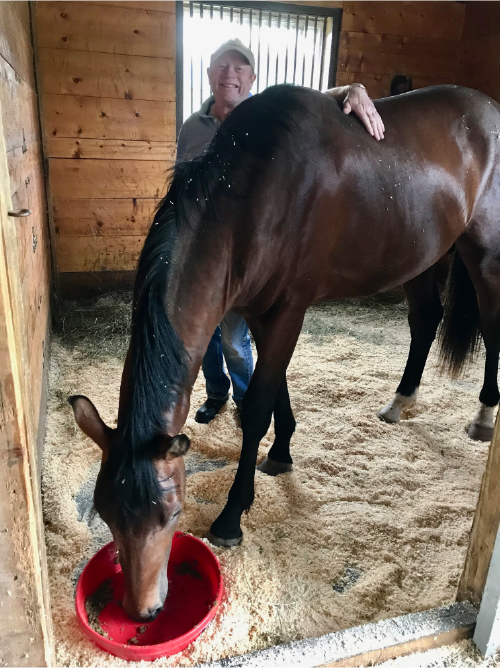 CH: Thank-you Paul, for sharing your training experience on this particular problem that you often see in Iberian horses. Are you currently working with any particular Iberian horses in your private yard?
CH: Thank-you Paul, for sharing your training experience on this particular problem that you often see in Iberian horses. Are you currently working with any particular Iberian horses in your private yard?
Paul: My pleasure. Yes, I have a homebred 3rd generation Lusitano/Andalusian/Dutch warmblood cross gelding out of one of my favorite mares of all time and perhaps the best one we ever bred, Gambol’s Georgy Girl. She was sired by Ashley Holzer’s black stallion Gambol who was on the Canadian dressage team. His name is Extravaganza WVH, though I call him Snoopy. His is sired by one of our longtime friends in Portugal own PSL/ANCCE horse, Briosso. A horse I’ve ridden in Portugal where he stands, many times and much enjoyed. My wife had to replace her Grand Prix horse Charrington due to a neuro issue that sadly popped up requiring euthanasia and she now has an Andalusian IALHA youngster we bought as a foal called Ferdi, registered name El Amable. We have downsized our operation at home and no longer run a horse breeding operation, so aside from these guys, our personal projects and the horses that come in mostly from other breeders for training throughout the year things are fairly quiet. Our worldwide clinic schedule keeps us busy. That was one reason we downsized. To focus on that side.
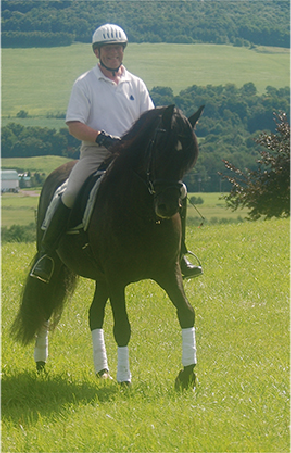 CH: Do you start horses under saddle at Willowview Hill Farm?
CH: Do you start horses under saddle at Willowview Hill Farm?
Paul: Not for other people. Not anymore. We only start our own horses because we have put the groundwork in beforehand and know what has been done in readiness for the starting of the horse under saddle.. Horses that come in for training need to be walk/trot/canter and have that basic level accomplished. We also often take in established show horses that require upgrading or polish for sale, and work with riders on their own horses to help them achieve the next level in their training program. While we do specialize at this point in Iberian horses, we are always open to all horse breeds.
If you would like to learn more about Willowview Hill Farm and the Alvin-Smith’s, both husband and wife are Grand Prix trainers, please visit www.WillowviewHillFarm.com or follow them on Instagram, YouTube or Facebook.


